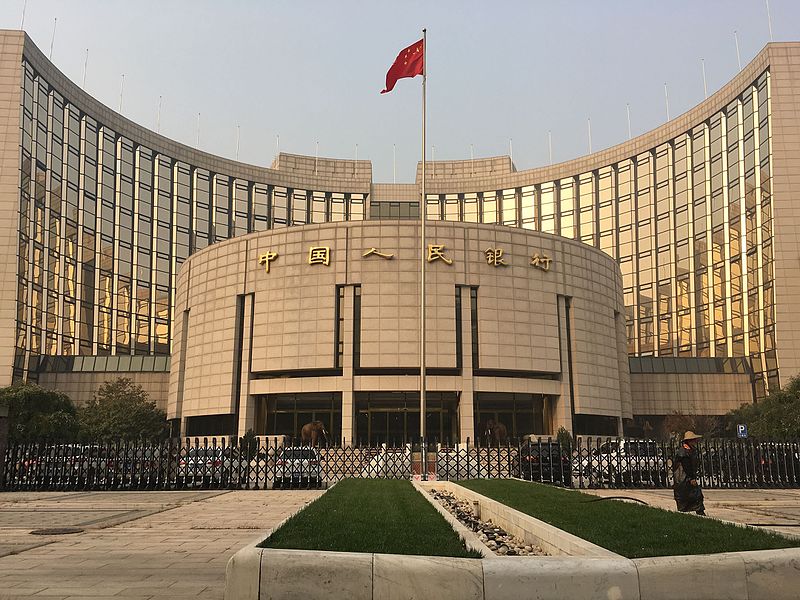
Will China Trigger Next Financial Tsunami?
By F. William Engdahl
9 August 2019
Image: Author:Max12Max - People's Bank of China Headquarter, Beijing - license: Creative Commons Attribution-Share Alike 4.0 Internationa Some rights reserved https://bit.ly/2yRMk1K
With the US decision to impose added tariffs on more than $300 billion of China trade, and the US Treasury declaring China a “currency manipulator”, global financial markets have reacted with sharp selling. The question is whether this is the beginning of a genuine currency war that will trigger a new Financial Tsunami as bad if not worse than that of the Lehman Crisis in 2008. The timing also coincides with escalation of geopolitical clashes between Washington and Venezuela, between India and China and Pakistan over Kashmir, between Turkey with Syria and with Cyprus, as well as the escalating tensions between Hong Kong and Beijing. Are we on the verge of a so-called “perfect storm” that will transform the post-1945 global order ?
After the breakoff of talks between Washington and Beijing at end of July, US President Trump announced his decision to impose added tariff sanctions on another $300 billion of China products. At that point the Peoples’ Bank of China (PBOC) let the exchange rate of the yuan fall below a psychological resistance level of 7.0 to the US dollar. It had kept the currency above 7.0 for more than a decade to stabilize US trade flows. US stocks reacted with one-day falls of well over 3%, paper losses over $1 trillion and a sharp rise in gold, as investors began to prepare for what could become a dangerous currency war with the world’s second largest economy. In addition, reneging on previous pledges to import more US agriculture products, the Beijing government ordered state buyers to stop all US agriculture purchases at the same time. As well, evidence grows that Beijing is making business more difficult for certain foreign firms in China.
Renminbi Currency Reserves
Although the PBOC over the next two days moved to stop the fall of the Renminbi (RMB), easing fears of all-out currency wars, as of this writing the China currency is poised to fall significantly, putting major pressure on other Asian export countries such as Japan and South Korea and India. At the same time China’s special financial window to the Western markets, Hong Kong, stands on the brink of a possible martial law and military crackdown from the PLA troops of the mainland, to end weeks of huge popular protest against new laws that would weaken agreed provisions of Hong Kong autonomy. Martial law in one of Asia’s major financial centers would not be positive for China’s efforts to get the China currency accepted as a major reserve currency for trade, a cornerstone of the government’s long term strategy. It would also not help China attract hundreds of billions of foreign investment in its own bond and stock markets.
What is not yet clear is whether this series of events portends the end of the globalization of the world economy on which China has built its impressive economic expansion on for the past three decades or so. One key issue is what impact the latest escalation of economic tensions between Washington and Beijing will have on the long-term strategy of making the China currency a major world reserve currency, a critical step for their future ability to fully integrate with global capital markets and expand their ambitious Belt Road Initiative. Here is where signs are that the latest moves to allow the Renminbi to break the critical 7.0 level may be more psychological warfare than actual full financial warfare.
After years of trying, China finally won acceptance of the Renminbi as one of only five world currencies composing the IMF Special Drawing Rights (SDR) currency basket along with the US dollar, British Pound, Japan Yen, and Euro in beginning of 2016. The aim has been that the Renminbi could begin to partly replace the dollar in world trade. Were that to happen it would be a major gain for China as a global financial factor and a major reduction of the role of the US dollar and US influence. Since 1945 US global hegemony has rested on two pillars–the US military as dominant and the dollar as world reserve.
Since the 1944 Bretton Woods agreement, the US dollar has been the dominant currency in world trade and also in world central bank reserves. With introduction of the Euro almost two decades ago, many predicted the dominance of the dollar would end and with it, an enormous advantage the US has to run US budget deficits financed by others including China whose trade surplus dollars inevitably go to buy US Treasury and related debt. Since the Greek crisis after 2010 exposed major flaws in the Euro architecture and the weakness of EU banks, the challenge from the Euro as alternative to the dollar has stagnated.
Latest IMF data show the dollar still holds some 61% of the world central bank reserves and still dominates world trade currencies with 40% of all payments in dollars while 30% are in Euro including the large intra-EU trade. As of 2018 the China RMB accounted for less than 2% of all global payments and around 1% of world central bank reserve holdings. This will become of vital importance to China now as it sees 25 years of unprecedented trade and balance of current account surpluses turn to deficit beginning this year or next.
China Surplus Falling
Current account surplus has defined China’s economic rise and her status as major source of global credit as the Peoples Bank of China (PBOC) invested record export surpluses into foreign assets, mainly government bonds, and much of that US government bonds. Some economists warn that the PBOC could deploy its financial weapon against US pressure by dumping an estimated $1.3 trillion of US bonds, likely collapsing the US economy in the process. Such dramatic action is however unlikely as China would become a major loser in the process. Not only would the value of China US bonds collapse, also China’s ability to attract hundreds of billions of foreign investment in China bond markets would be at high risk.
This year for the first time in 25 years China is likely to run a deficit in its current account. Current account, the sum of trade balances and capital flows, has been hugely positive for China since the mid-1990s as it became the cheap labor “workshop of the world.”
China Needs Foreign Investors
This year for the first time in nearly 25 years China is expected to have a deficit on its Current Account. This is no small matter. A new report by Wall Street bank, Morgan Stanley, estimates that to balance this growing deficit China will need to attract billions in foreign investment. The report states, “Due to the ongoing transition to a consumption-led economy and a decline in savings amid an aging population, China’s annual current-account deficit could reach as much as 1.6% of GDP—or $420 billion—by 2030.” If true, that is a huge shift in dependence for China. In terms of surplus in goods exports, China has already gone from a surplus of 10% of GDP in 2007 before the major financial crisis, to 2.9% in 2018. This year could be a small deficit.
Today foreign investment in China bonds is small at about $35 billion. Morgan Stanley estimates the size of China’s bond market, the heart of the debt system, to be over $12 trillion, third behind Japan with $13 trillion and USA with $40 trillion, but larger than say UK or France.
As China’s economy undergoes a major shift to current account deficit over the next few years, it must be able to attract new inflows of investment in its debt from outside. This is a huge problem potentially. This also explains a major reason behind China’s push to develop state-of-the-art advanced industry in its Made in China 2025 strategy that is the true target of Washington trade pressure.
At this juncture it looks like a high-risk game of financial chicken between Beijing and Washington. It appears clear that Xi Jinping has decided to hunker down and hold out until the US elections next year in hopes Trump will lose to a pro-China Democrat. What is clear is that this is about far more than any imbalance in China’s trade with the USA.
F. William Engdahl is strategic risk consultant and lecturer, he holds a degree in politics from Princeton University and is a best-selling author on oil and geopolitics, exclusively for the online magazine “New Eastern Outlook”
